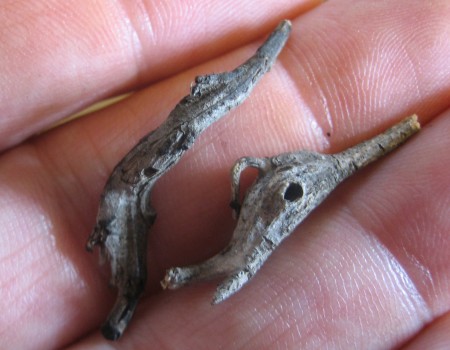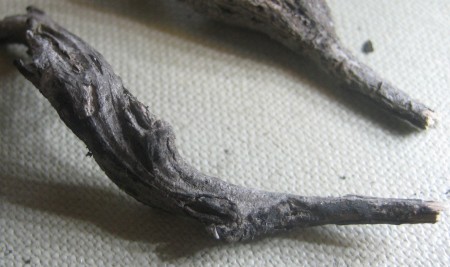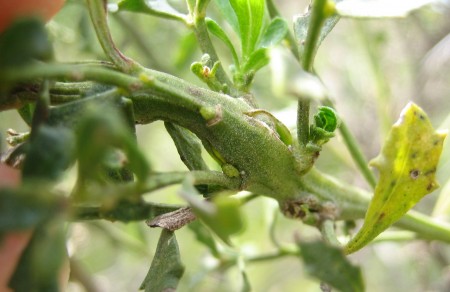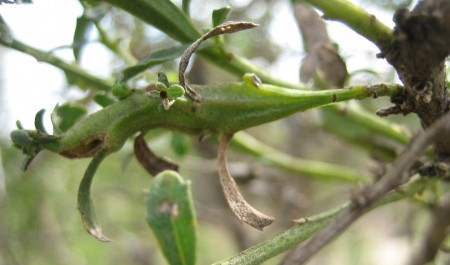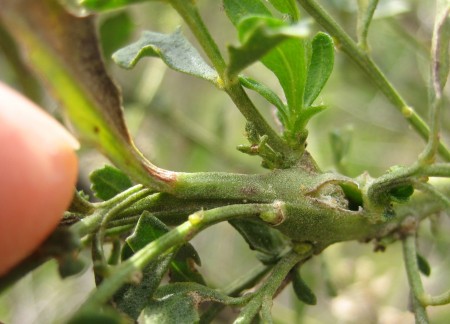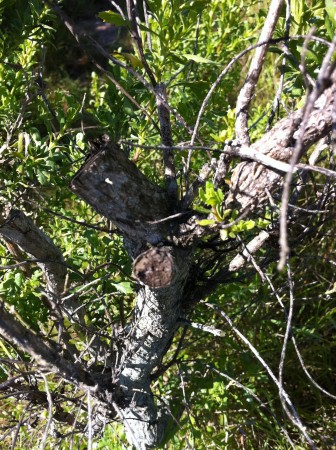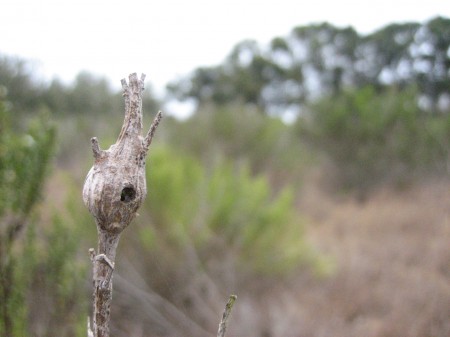I took this photo at the Carp salt marsh last Sunday, October 30, 2011. It shows a time at the marsh that is my favorite in two ways: It’s the peak of the coyote brush blooming season, with the female coyote brush looking like they’ve been dusted with snow, and at the time I took this photo the marsh was at a +6 high tide:
Archive for the ‘Coyote Brush’ Category
Coyote Brush in Bloom
Tuesday, November 1st, 2011The Case of the Twisted Stem
Sunday, October 16th, 2011Yesterday Linda and I took a brief hike on the Jesusita Trail in Santa Barbara. The area we were walking through was burned in a 2009 wildfire, but it has mostly recovered now. Still, there are signs of the fire — blackened stumps and twigs — if you look for them. There is also a fair amount of coyote brush (Baccharis pilularis), so naturally that ended up being the focus of my attention.
I was surprised to see that there were no Rhopalomyia californica bud galls on any of the plants. I’m not sure why that is. Maybe it’s a legacy of the fire, with the gall midges taking a while to reestablish themselves. Or maybe this is typical of coyote brush stands higher up in the foothills. The Jesusita trailhead is more than three miles inland, while most of my experience with coyote brush has been at the salt marsh and the Carpinteria bluffs, right next to the ocean. Maybe R. californica is more of a coastal species?
At one point I was looking at a spindly clump of burned stems emerging from the center of an otherwise-green coyote brush, when I realized that the exposed stems had the characteristic thickening of the twisted stem gall midge, Rhopalomyia baccharis. I broke off a few of the galls and brought them home for closer examination. Here they are in my hand, to give you a sense of scale:
If you look closely at this shot, you can see the elliptical openings through which the adult midges emerge:
I think these twisted stem galls are fascinating, and I’m always looking for them, but whether it’s that they’re actually rarer, or just that they’re harder to spot in the foliage, I almost never find them. I come across dozens of terminal bud galls for every twisted stem gall I find.
Back in February I found a coyote brush at the Carpinteria salt marsh that had a lot of twisted stem galls; eight or nine at least. I was excited by the find, but I was also in something of a hurry, so I just snapped a few quick photos, intending to come back later and investigate in more detail. Here are some of the shots I got:
The next chance I had to visit the marsh was a few weeks later. I assumed I’d be able to find the plant quickly (the galls gave it a distinctive, gnarled appearance), but I ran out of time without finding it. By the time I could get back to the marsh for a more thorough search it was early April. Even looking more carefully, though, I couldn’t locate the plant. One was in the right spot, but it was much smaller than the plant I remembered, and had no visible galls, so I dismissed it quickly.
Where were the stem galls? I really had seen them; I had photos to prove it. But now they just weren’t there. I wandered back to the center of my search pattern, next to the small coyote brush, and stood there scowling.
And happened to take a closer look at the plant:
Oh.
I suddenly remembered a conversation I’d had recently with Andrea, the head of the docent program, about some new workers hired by the city, with whom she’d had words about their over-zealous pruning of the native plants. The workers had seen the coyote brush with its noticeably gnarled stems, and had done what any self-respecting gardener would do: They’d pruned away the damaged branches.
Sigh. My quest for twisted stem galls continues.
Chaparral Mallow in Bloom at the Carpinteria Salt Marsh
Tuesday, July 26th, 2011If you haven’t been to the Carpinteria salt marsh in a while, this is a great time to visit. The chaparral mallow (Malacothamnus fasciculatus) is in bloom, making the walk to the amphitheater a fairly surreal experience:
I traded docent shifts with Rob Denholtz this month, so I was there on the third Saturday in July, rather than my usual second Saturday. No one showed up for the tour, though, so I took a stroll through the marsh myself, and was rewarded by a breathtaking profusion of purple flowers.
I’m on record as having a crush on coyote brush (Baccharis pilularis). Linda attended a recent talk by Carol Bornstein, author of Reimagining the California Lawn, and Linda told me coyote brush was among the plants Bornstein discussed.
Bornstein wrote in her book about coyote brush’s “utilitarian” character, and Linda said she called it “fairly drab” during her talk, which of course makes me want to rise to its defense. But I admit that its flowers are not the showiest.
Chaparral mallow is another story. If I have a crush on coyote brush, I felt a temporary transfer of affections to chaparral mallow as I walked past the wall of flowers at the marsh. You really should visit while they’re in bloom.
Three Dried Galls
Friday, January 7th, 2011I’ve been reading Ron Russo’s Field Guide to Plant Galls of California and Other Western States. I first heard about the book several years ago from Andrea Adams-Morden, the head of the docent program at the Carpinteria Salt Marsh. It didn’t really excite my curiosity at first; I’d been drawn to the marsh by my interest in birds, and didn’t know much about plants and insects. Over time, though, as my appreciation of the marsh ecosystem grew, galls began to seem more interesting, and eventually I went ahead and bought Russo’s book.
I’m glad I did. Field Guide to Plant Galls is a book that combines lots of detailed technical information with an infectious sense of wonder. And it turns out that galls really are quite interesting.
Russo writes:
Galls are tumorlike grows of plant tissue produced by the host plants in response to the chemical and/or mechanical stimuli of invading organisms (fungi, mites, insects), resulting in accelerated production of plant growth hormones…
Since the galls of many insects (especially wasps and many flies) are specific to their species in size, shape, and color, there is most likely some genetic programming relationship between the compounds provided by the adults or larvae and the manifestations of plant cellular tissue as influenced by the host’s own hormones. Something in the chemicals provided by gall organisms directs the expression of normal plant genes in the development and expansion of the host plant’s tissues. Scientists have been looking for a long time for this “blueprint” that seems to control gall characteristics. This has become the “Holy Grail” of gall research.
The complex relationships between gall inducers, host plants, and the communities of inquiline and parasitic species that associate with them are fascinating — and mysterious. Again and again in the book, Russo calls attention to the limits of current knowledge. Science increases the amount we know, but it also increases the amount we don’t know, in the sense that the larger an island becomes, the more extensive its shoreline. Russo’s enthusiasm for splashing around at the water’s edge is contagious.
One interesting aspect of galls is that they can persist for a long time. In this post I’m going to look at three old, dried galls that I discovered on my botanical crush, Baccharis pilularis, long after the original inhabitants were gone.
Gall #1: Rhopalomyia californica
One of the most common galls on coyote brush is the one created by the coyote brush bud gall midge, Rhopalomyia californica. I wrote previously about finding this old, dried-out R. californica gall:
I had read that R. californica was used successfully to curb an invasive weed in Australia (not coyote brush, but a related species, groundsel bush, Baccharis halimifolia). Recently I googled up some interesting material about that.
The host specificity of Rhopalomyia californica Felt (Diptera: Cecidomyiidae) and its importation into Australia as a biological control agent for Baccharis halimifolia L. is a journal article by W. A. Palmer, G. Diatloff, and J. Melksham. Originally appearing in Proceedings of the Entomological Society of Washington in 1993, it includes this description of R. californica’s life cycle:
Briefly, adults emerge from the gall in the first few hours after daybreak and mate soon after their emergence. Males are particularly short lived (2-4 hours) while females live 12-14 hours and occasionally longer. Females can be recognized by their orange abdomen, the coloration of which is caused by the mass of vermillion colored eggs. They oviposit approximately 100-150 eggs on the surface of meristematic tissue at stem terminals and occasionally in leaf axils. Neonate larvae enter the stem between bud scales and produce a gall on the stem. A number of larvae form a community gall and these galls can contain more than 50 chambers each housing one larva. The larvae complete their development and pupate within the gall. Flies emerge within two months after oviposition.
I also found a Google Books link for Pests of field crops and pastures: identification and control by Peter T. Bailey. The book includes this photo of a female R. californica laying its eggs on B. halimifolia:
I still haven’t seen an adult midge on coyote brush, but I’ll have a better idea what to look for now. I also really want to see a gall with the insects’ pupae protruding from its surface, or with the spent exuviae left behind after the adults emerge. Chuck Baughman has some beautiful pictures of what I think are exuviae (though he commented previously that he thought they might be the bodies of emerging adults killed in a cold snap); they’re definitely worth checking out at BugGuide: Coyote Brush Bud Gall Midge - Rhopalomyia californica.
Gall #2: Rhopalomyia baccharis
In many cases it is easier to identify gall-inducing insects by their galls, rather than by the insects themselves. That’s the case with another Rhopalomyia midge that forms galls on coyote brush, Rhopalomyia baccharis, the coyote brush stem gall midge. The insect itself is more or less indistinguishable from R. californica. But the gall it produces is very different.
I’d been looking for these galls (unsuccessfully) for the past few months, and then last week I noticed an odd thickening on a dead stem. It looked smaller to me than the galls I’d been looking for, but in hindsight that was my mistake; after removing the object, bringing it home and measuring it, I realized that it perfectly matches Russo’s description of “50 to 90 mm long by 5 to 8 mm in diameter”:
Once I examined it up close I was also able to see what I believe are the odd, elliptical openings that form at the outer ends of the gall’s individual larval chambers:
According to Russo:
The rounded-edged, elliptical holes are not typical of the normal sharp-edged, round exit holes created by insects, and they do not appear to have been chewed open. While we have no clear answer at this point, the convenient exit holes appear to be created by the plant after larvae have stopped feeding and stimulation from the larvae has ceased. These holes develop before the larvae (at the bottom of the chambers) change into pupae. Shortly after the holes are created, pupae develop and remain at the bottom of the chambers. Pupation occurs inside the galls, and the adults emerge through the openings in November and December. These unique circumstances make this species stand out from all of its relatives in which the pupae partially push their way out of the gall before the adult emerges. Much more needs to be learned about the habits of this mysterious and interesting gall midge.
Gall #3: Gnorimoschema baccharisella
My favorite line from the movie Men in Black is when Frank the pug observes:
You humans. When’re you gonna learn that size doesn’t matter? Just ’cause something’s important, doesn’t mean it’s not very, very small.
My final gall illustrates this point nicely.
I’ve written previously about the gall of the Baccharis stem gall moth, Gnorimoschema baccharisella. Here’s an image I previously posted of an old, dried G. baccharisella gall at the bluffs:
These galls are monothalamous, meaning that each gall contains a single larval chamber. Russo describes how the larvae chew exit holes, then drop to the ground to pupate. But that’s not the end of the story for the galls:
The frass that accumulates inside the gall serves as a culture medium for various fungi, which are eaten by several fungus insects after departure of the moth. Tilden (1951) found at least 10 parasites associated with this moth in addition to 17 other insects that were connected to the gall or the moth in some manner. The intricacies of these complex relationships stagger the mind for such a common, yet so disregarded, shrub.
The other day at the bluffs William and I came across an old G. baccharisella gall. I removed it and handed it to him, pointing out the emergence hole. He took his scientific curiosity a step farther than I had: He broke it in half.
Looking inside it, he made a discovery. “What are these yellow things? They look like eggs.”
They did. But after bringing the gall home and examining it more closely, I think they may be the fruiting bodies of some kind of fungus. Here are some closeups:
While examining these through the handheld microscope Linda gave me for Christmas, I noticed something crawling around. Here’s the video I took of it:
I’m not sure, but I think that’s a fungus mite of the order Mesostigmata (see, for example, this similar-looking mite at BugGuide).
I few years ago I would have overlooked all three of these galls. But with helpful people like Ron Russo showing me the way, I’m learning to look closer.
More Obsessing about Coyote Brush
Monday, November 8th, 2010A running joke in my family these days is that I have a crush on coyote brush. We were playing “20 Questions” at the dinner table a few nights ago (anything to get William beyond grunting), and when it was my turn to choose and I announced, “vegetable,” William got it in one, asking with a roll of his eyes, “Is it coyote brush?”
Sigh. I can’t help it. That plant is just so cool.
I previously wrote about the infestation by what I believe was orange tortrix (Argyrotaenia franciscana) along the trail below the Sidenberg Overlook at the bluffs. The infestation was really bad for a while, but the plants have bounced back. Coyote brush has co-evolved with A. franciscana over a very long span of time; apparently the occasional infestation is no big deal. The same plants that basically had no healthy-looking foliage at all two months ago now look like this:
We’re reaching the end of the flowering season for coyote brush, and some of the female plants look like they’re covered in snow. Here’s a closeup of some seeds getting ready to set sail:
When you start paying attention to coyote brush, you can’t help but notice the great variety of insects that associate with it. Here are some photos I’ve taken lately.
Bob Carlson, a retired entomologist who previously did postdoctoral work studying Ichneumonidae, was nice enough to comment on these images I uploaded to Bugguide. He thinks the bluish tint to this small wasp’s eyes suggest that it might be a male (because it lacks the female’s long ovipositor) of the Agathidinae subfamily:
Here’s another wasp, this one crawling around on a Rhopalomyia californica bud gall. It’s not a great photo, but I’m wondering if this might be a species of Torymus, a group of parasitoid wasps that prey on the larvae of gall midges.
No luck so far on an ID for this fly, but after I posted its image at Bugguide and asked for any ideas about what was going on with that bubble of liquid coming from the fly’s mouth, I got a pointer to this interesting discussion: tiny bubbles.
According to my copy of Russo’s Field Guide to Plant Galls of California and Other Western States:
Coyote brush (B. pilularis), also called chaparral broom, is one of the most interesting shrubs entomologically. Tilden’s monumental study (1951) of this shrub identified over 221 species of insects associated with it, as well as eight species of mites. The insects, in turn, hosted an additional 62 species of parasites for a total of 291 species on coyote brush…
As mentioned earlier, the intricacies of host plants, gall inducers, parasites, and inquiline relationships, especially as exemplified by the coyote brush regime, are vastly complicated and a worthy subject for additional study in the future.
You hear that, scoffers? “A worthy subject”!
The Tilden referred to in that passage is James Wilson “Bill” Tilden, who passed away in 1988. He did his 1948 doctoral dissertation at Stanford on the insect associates of B. pilularis. The dissertation was 408 pages long, according to this obituary published in the Journal of the Lepidoptrists’ Society: James Wilson Tilden (1904-1988): A Remembrance (PDF file). I’d love to get a copy of that dissertation.
Not quite as long, but still very much a current object of my desire, is the “monumental study” Russo refers to, Tilden’s 1951 paper, “The Insect Associates of Baccharis pilularis De Candolle”. It was published in Microentomology, a journal that hasn’t yet made it onto the Web, unfortunately. The paper is 39 pages long, and according to a reference I was able to google up, they have a copy at the UCLA Biomedical Library. I think I’m going to have to pay a lunchtime visit to Westwood during one of the days when I’m working in Santa Monica.

